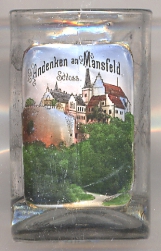

|
| DEUTSCHLAND | GERMANY |
| Bundesland: Sachsen-Anhalt | Saxony-Anhalt |
| Landkreis: Mansfeld-Südharz |
Mansfeld is situated at an elevation of 255 m in the eastern foothills of the Harz mountains, about 35 km northwest of Halle (Saale). The municipality has a population of about 9,300 (2013). Together with Lutherstadt Eisleben and Lutherstadt Wittenberg, Mansfeld is one of three cities in Germany that bear the name 'Lutherstadt' (Mansfeld-Lutherstadt) due to their historic connection with the reformer Martin Luther.
Mansfeld was chartered as a town already in 1400. The most important economic factors for its development at that time were silver and copper mills. After the death in 1780 of the last count of Mansfeld the town came in possession of the Brandenburg-Prussian duchy of Magdeburg. In 1807 Mansfeld became part of the Napoleonic kingdom of Westphalia (district Halle within the département de la Saale). Following the Congress of Vienna (1815) Mansfeld was returned to Prussia and became part of the district Mansfelder Seekreis (with administrative seat in Eisleben) of the Prussian Province Saxony. The town of Leimbach was incorporated into Mansfeld in 1950, followed by further eight neighbouring municipalities (Annarode, Biesenrode, Gorenzen, Großörner, Möllendorf, Piskaborn, Siebigerode and Vatterode) in 2005 and another six (Abberode, Braunschwende, Friesdorf, Hermerode, Molmerswende, Ritzgerode) in 2009.
 The father of the famous reformer Martin Luther, the foreman Hans Luder, settled in Mansfeld in 1484. Luther spent his early youth here and went to the local school
from 1488 until 1496. The building named 'Luthers Schule' was demolished due to structural defects and was rebuilt in 2000. Luther's parental home today houses a museum.
For this reason Mansfeld in 1996 was awarded the name affix 'Lutherstadt' (Mansfeld-Lutherstadt).
Together with Augsburg, Coburg, Eisenach, Eisleben, Halle,
Heidelberg, Magdeburg, Marburg, Nordhausen, Schmalkalden,
Speyer, Torgau, Wittenberg, Worms and Zeitz
it is also one of the sixteen members of the 'Bund der Lutherstädte' (Association of Luther Towns), which was founded in 1993 as an association of those places that were important
for Luther's life.
The father of the famous reformer Martin Luther, the foreman Hans Luder, settled in Mansfeld in 1484. Luther spent his early youth here and went to the local school
from 1488 until 1496. The building named 'Luthers Schule' was demolished due to structural defects and was rebuilt in 2000. Luther's parental home today houses a museum.
For this reason Mansfeld in 1996 was awarded the name affix 'Lutherstadt' (Mansfeld-Lutherstadt).
Together with Augsburg, Coburg, Eisenach, Eisleben, Halle,
Heidelberg, Magdeburg, Marburg, Nordhausen, Schmalkalden,
Speyer, Torgau, Wittenberg, Worms and Zeitz
it is also one of the sixteen members of the 'Bund der Lutherstädte' (Association of Luther Towns), which was founded in 1993 as an association of those places that were important
for Luther's life.
 Mansfeld castle [left] was first mentioned in 1229.
After a large fire had destroyed the old castle in 1509, three separate castle in early Renaissance style were built on its site. The names of the three castles, Vorderort, Mittelort
and Hinterort, also became the name of the three lines of the counts of Mansfeld that had been formed by a partition in 1501. In terms of art history, the three castles were in
the same group as the Albrechtsburg in Meißen and the castles of Merseburg and Bernburg.
A large fortress, separate from the castles and one of the largest in all Germany, was created in 1517–1549.
As the counts of Mansfeld lost their fortune, not lst due to the costs of upkeep of the castles, their property was divided in 1579 between the electorate of Saxony and the
archbishopric of Magdeburg. Castles Hinterort and Mittelort fell into decay in the late 16th century. in 1650, the fortress was given into the care of
count Mansfeld-Hinterort. In 1674/75 the fortress was finally demolished and since then only ruins of it remain. Castle Vorderort was the only part of the whole complex which
was still kept in good condition. In 1859–1861 baron Carl Adolph von der Recke, who had obtained the castle, rebuilt castle Vorderot in Gothic revival style
[see picture on glass no. 2994, left]. The family was dispossessed in 1945. Sicne 1946 the castle was in possession of the state of Saxony-Anhalt. In 1999 it was
handed over to the 'Förderverein Schloss Mansfeld' which runs it as a Christian Youth educational and meeting place.
Mansfeld castle [left] was first mentioned in 1229.
After a large fire had destroyed the old castle in 1509, three separate castle in early Renaissance style were built on its site. The names of the three castles, Vorderort, Mittelort
and Hinterort, also became the name of the three lines of the counts of Mansfeld that had been formed by a partition in 1501. In terms of art history, the three castles were in
the same group as the Albrechtsburg in Meißen and the castles of Merseburg and Bernburg.
A large fortress, separate from the castles and one of the largest in all Germany, was created in 1517–1549.
As the counts of Mansfeld lost their fortune, not lst due to the costs of upkeep of the castles, their property was divided in 1579 between the electorate of Saxony and the
archbishopric of Magdeburg. Castles Hinterort and Mittelort fell into decay in the late 16th century. in 1650, the fortress was given into the care of
count Mansfeld-Hinterort. In 1674/75 the fortress was finally demolished and since then only ruins of it remain. Castle Vorderort was the only part of the whole complex which
was still kept in good condition. In 1859–1861 baron Carl Adolph von der Recke, who had obtained the castle, rebuilt castle Vorderot in Gothic revival style
[see picture on glass no. 2994, left]. The family was dispossessed in 1945. Sicne 1946 the castle was in possession of the state of Saxony-Anhalt. In 1999 it was
handed over to the 'Förderverein Schloss Mansfeld' which runs it as a Christian Youth educational and meeting place.
![[scale]](lineal.jpg)